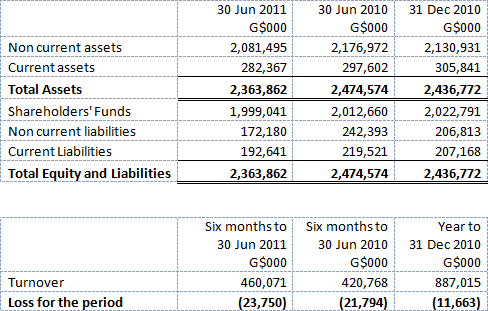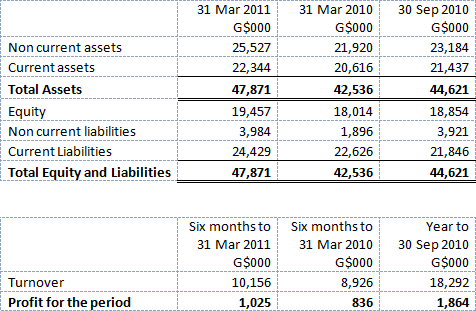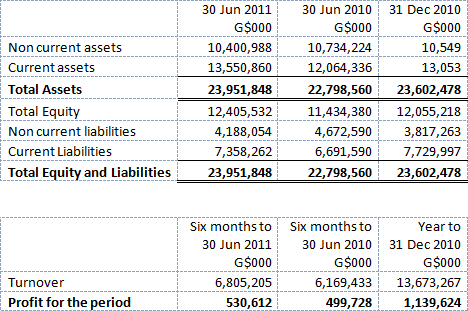Introduction
Caribbean Containers Inc, a public company in the paper recycling business has reported turnover for the first half of 2011 increasing by 9.3% over the same period last year. This follows a 10.3% reported turnover increase by the DDL Group of Companies and a 13.8% increase in the Banks DIH Group, the only one of the three with a September 30 year-end while CCI and DDL have a December 31 year end. The increases in turnover are of course considerably higher than the rates of inflation in the economy. Banks DIH in explaining its improved performance cited higher dollar sales, a term usually used in contradistinction from volume sales.
CCI reported a gross profit increase over 2010 of 14.3% but its losses before tax increased from $21.8 million to $23.8 million. The report shows Earnings before depreciation as having declined in the first half of the year by 31.3% and that margins were severely affected by the rapid escalation in global fuel prices which resulted in the company’s fuel bill going up by some 40%.
The company’s performance in the third quarter ended September 30, 2011 improved strongly with an 18.3% growth in Earnings before depreciation compared with third quarter 2010. The result was a modest profit before tax of $2.7 million compared with a loss of $10.2 million for the third quarter of 2010. The overall result was a sharp decline in loss before tax for the nine months from $32 million in 2010 to $21million in 2011. The report explained that over the last four years, sales in the second half of the year averaged 13% more than in the first half.
CCI has had its fair share of financial problems over the years with a number of ownership changes and substantial debt restructuring. As at June 30, the company had liabilities of $365 million including trade and other payables of $116 million and loans repayable within a year amounting to $69 million. Cash resources amounted to $37 million but this had gone down to $25 million three months later.
In what can be described as Guyana’s principal LCDS private sector company, survival is still the challenge as the company’s aging technology has high running and maintenance cost, placing cash management at the centre of management focus.
Yet the company deserved commendation for being the only private sector company other than Republic Bank (Guyana) Limited to publish quarterly financial reports. The Bank of Guyana had published and recently withdrew Guideline # 10 requiring all banks to publish quarterly statements.
The half-yearly report is a consolidated report of the food and beverage giant and its subsidiary Citizens Bank Guyana Inc. Given the disparate nature of the operations and business of the two entities such a consolidated report does not allow any easy informed analysis of the two businesses.
The company had unaudited profit after tax in the half-year of $689.5 million compared to $594.1 million in 2010, an increase of $95.4 million or 16%. Chairman and Chief Executive of the group explained in the report that the improved results came mainly from increased dollar sales, efficiencies derived from Plant and Machinery upgrades and the benefits obtained from the installation of Capital Equipment.
The subsidiary Citizens Bank achieved an unaudited profit after taxation of $364.6 million compared to $261.0 million in 2010.
Total group profit after taxation for the half year was $1,025 million compared with $836 million, an increase of some 22% and a resulting increase in Earnings per Share from $0.71 per share to $0.85 per share.
A meaningful cash flow commentary is not possible as the cash and bank resources of the company cannot be distinguished from those of the banking subsidiary. Inventories, the bulk of which would be for the company stood at $4,367 million, increasing from $4,069 million one year earlier. For the type and nature of the operations this seems reasonable, particularly when compared with DDL to which we now turn attention.
This group comprises several local and overseas companies in the region, North America and Europe as well as a joint venture in India and associated companies in Guyana and Jamaica. In his Chairman’s Statement Dr. Yesu Persaud reported that the group’s pre-tax profit for the half-year of $769 million had increased by 6.4% over 2011, attributed to the performances of the European subsidiary, Demerara Shipping Company Limited and Distribution Services Limited.
When account is taken of increases in the fair value of investments and exchange differences on consolidation, the total comprehensive income for the year – a measure of the sum total of all operating and financial events that have changed the value of an owner’s interest in a business – is $627 million compared with $437 million in 2010. The group may have a challenge however in exceeding the full year reported profits for 2010 of $1,139 million. The profits for that year were augmented by a $151 million “share of profit of associated company.” In the first six months of 2011 this profit was only $8.4 million compared with $3.4 million in 2010 half-year, suggesting some major development in the second half of that year.
Earnings per share (EPS) have increased from $0.65 in half-year 2010 to $0.69 in 2011.
The balance sheet continues to be fair with current assets exceeding current liabilities by a ratio of nearly 2:1. The problem lies however in the composition of the two balance sheet components. Trade payables have climbed to $4 billion, bank overdraft is $2.8 billion and loans repayable in the next twelve months is close to half a billion dollars.
Share prices
None of the reports bother to speak of one of the most important issues for shareholders and that is the performance of the companies’ shares on the Stock Exchange. A comparison of recent prices is shown below:




